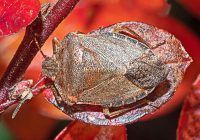Dr Phil Smith’s Wildlife Notes
November 2020
Although rain fell in Formby on 17 days, amounts were small. Therefore, November turned out to be much drier than October, with no change in the water-level at the Devil’s Hole. It was relatively mild with hardly any frost. As a result, occasional summer flowers, such as Evening Primrose, Ragwort and the Hybrid Stork’s-bill enlivened the dunes throughout the month.
Sun was at a premium but I could still find some of my beloved insects on the few remaining Ivy flowers at Ravenmeols or on a sheltered, south-facing fence at Wick’s Path, Formby Point. Ravenmeols seemed quiet on 4th but I hung around and eventually chalked up eight different hoverflies, the best being a very wary Pale Knobbed Didea (Didea fasciata). Although widespread, this is a generally scarce woodland species. A late Peacock was unexpected and I photographed a tachinid fly, later identified by Chris Raper as Sturmia bella, a parasite of butterfly caterpillars, including the Peacock and Small Tortoiseshell. Some have claimed that its northerly spread may be partly responsible for the declines of these butterflies.
Two days later, Wick’s Path also came good, with three Dock Bugs and two Green Shieldbugs. One of the latter was beginning to turn brown, the other being completely brown so that it matches dead leaves before hibernating. The real highlight, however, was an immature Western Conifer Seedbug, a non-native introduced from the USA and only the second I have ever seen. Wick’s Path still had three hoverfly species and a brown Green Shieldbug on 17th, while White Dead-nettle was in full flower. My last hoverfly there was a single Drone Fly (Eristalis pertinax) on 22nd.
Pete Kinsella emailed to say that the wintering Mediterranean Gull was back on Southport Marine Lake, so I ventured up the coast road on 9th. It was there, sure enough, but wasn’t tempted to come close by my offerings of stale bread, unlike hoards of Black-headed and Herring Gulls. Moving on to Marshside, I joined a hardy band of ‘marsh watchers’ and was rewarded with close views of female Hen and Marsh Harrier with more distant male Hen Harrier and Merlin.
The middle of the month saw a sequence of 10m spring-tides with strong to gale force onshore winds. Fearing the worst, I went to Hightown to check the amount of erosion on the dune frontage. It wasn’t as bad as I expected, with only about 1-2m lost but the big tides have washed away most of the low dunes at the northern end and have started to cut into the large reed-bed. The wader roost off Altcar Rifle Range held about 400 Curlew and 250 Oystercatchers, while a Little Egret was feeding along the edge of the Alt. I also said “Hello” to the Common Seal that has been around for about a year. It was swimming in the main channel but did not haul out while I was there. As I walked back along the shore, I noticed the remains of wooden posts sticking out of the beach. These were put in along the outer edge of the sand bunds that were dumped here nine years ago to slow down the erosion. In places, the posts are up to 29m from the current dune frontage, showing how much sand has been lost since 2011. A few days later, I visited the frontal dune rampart at Formby Point where the steep erosion cliffs towered above me. Here, I estimated losses of 2-3m. As at Hightown, it could have been worse.
On 18th, I met Andrew Brockbank at Ravenmeols dunes to identify patches of invasive Sea Buckthorn for eventual removal. Andrew is shortly to retire after long and distinguished service with the National Trust. Another outdoor, socially distanced meeting was with Natalie Hunt of Natural England. I joined her at the Montagu Road Triangle, Freshfield, to walk over the area of dune-heath that was cleared of trees and scrub last winter. We were delighted to see a mini-forest of Heather seedlings springing up, while many rosettes of the regionally notable Bird’s-foot was also an encouraging sight. Another area of scrub is planned for removal in January but we agreed that several young oaks with interesting mosses and liverworts growing on their branches should be left.
At this time of year, reports come in of unusual discoveries earlier in the year. Perhaps the most surprising was Tawny Cockroach (Ectobius pallidus) found in two places on Hightown dunes by Tony Hunter of Liverpool Museum. This small, native cockroach is described in the books as very local in southern England, most records being south of the R. Thames. How did it get here?!
Finally, Gary Hedges, also from the Museum, set out on 4th June to search for the Ainsdale Dung Beetle (Ammoecius brevis) a tiny scarab known only from sand-dunes between Southport and Ainsdale. It was listed in 2016 as ‘critically endangered’ and possibly extinct. A 2017 survey found a few of them in Ainsdale Sandhills Local Nature Reserve, an exciting re-discovery. Gary counted 82 on dry cow-dung in Ainsdale National Nature Reserve without trying too hard! Maybe it isn’t as endangered as we once thought.






